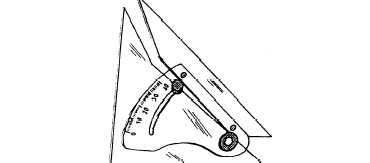microform reproduction. There are two types: fired
and extruded. They are similar in material content to
plastic fired lead, but they are produced differently.
The main drawback with this type of lead is that it does
not hold a point well.
PENS
Two types of pens are used to produce ink lines:
the ruling pen with adjustable blade and the
needle-in-tube type of pen (fig. 2-2). We include the
ruling pen here only for information; it has been
almost totally replaced by the needle-in-tube type.
The second type and the one in common use today
is a technical fountain pen, or needle-in-tube type of
pen. It is suitable for drawing both lines and letters.
Figure 2-5—Adjustable triangle.
The draftsman uses different interchangeable needle
points to produce different line widths. Several types
of these pens now offer compass attachments that
allow them to be clamped to, or inserted on, a standard
compass leg.
DRAWING AIDS
Some of the most common drawing aids are
protractors, triangles, and French curves. A protractor
(fig. 2-3), is used to measure or lay out angles other
than those laid out with common triangles. The
common triangles shown in figure 2-4 may be used to
measure or lay out the angles they represent, or they
may be used in combination to form angles in
multiples of 15°. However, you may lay out any angle
with an adjustable triangle (fig. 2-5), which replaces
the protractor and common triangles.
The French curve (fig. 2-6) is usually used to draw
irregular curves with unlike circular areas where the
curvature is not constant.
TYPES OF LINES
The lines used for engineering drawings must be
clear and dense to ensure good reproduction. When
making additions or revisions to existing drawings, be
sure the line widths and density match the original
work. Figure 2-7 shows the common types of straight
Figure 2-6.—French (irregular) curves.
2-3

